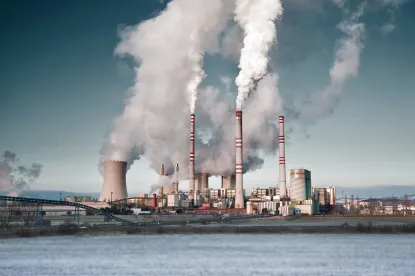One of the US Supreme Court’s final opinions this term addressed US Environmental Protection Agency’s (EPA) authority to regulate greenhouse gases (GHGs) under the federal Clean Air Act (CAA). The decision in West Virginia v EPA holds that Section 111 of CAA does not grant plenary authority to EPA to address GHGs from power plants in the manner EPA proposed, which required shifting generation from existing sources to new, zero-emitting GHG sources. Below, we discuss both technical CAA-focused aspects of the decision as well as potential broader implications for administrative law. One key takeaway is that the Court’s holding here is narrowly focused on the unusual context of remaking the energy generation markets.
Case Background
The facts leading to this decision are complicated and we’ve previously discussed them in other places: see here (discussing the Affordable Clean Energy (ACE) rule’s (ACE) predecessor, the Obama Administration’s Clean Power Plan (CPP)), and here and here (prior coverage of ACE). To summarize the procedural history:
-
The CPP was promulgated in 2015 during the Obama Administration but was stayed by the Supreme Court while lower-court challenges remained pending;
-
CPP was repealed by the Trump Administration which — by rulemaking — replaced it with the Affordable Clean Energy (ACE) Rule in part based on a finding by EPA that CPP fell under the “major question doctrine,” and established a different scheme to regulate GHGs from power plants; and
-
Before ACE entered into effect, parties challenged ACE in the D.C. Circuit, which held that the repeal of CPP was improper, and thus vacated ACE. In the meantime, the Biden Administration had informed the Court that it was working on a new rule and urged that the case challenging ACE was moot.
The DC Circuit’s decision vacating ACE was appealed and the case made its way to the Supreme Court.
The Supreme Court Decision
The Supreme Court’s decision is found in a six-member majority opinion authored by Chief Justice Roberts; a two-member concurrence authored by Justice Gorsuch; and a three-member dissent authored by Justice Kagan. We will summarize each of these briefly below.
Majority opinion. After addressing procedural issues like standing, the Court wades into the particulars of what authority Congress delegated when it passed and amended the CAA. The Court looks at the rules and the statute and finds that a “major question” is presented, requiring a deeper analysis. The Court found that EPA is allowed under Section 111 of the CAA to regulate emissions from stationary sources. However, the Court ruled that the plain language of Section 111(d) did not authorize EPA to effectively remake the energy markets through regulation, and Section 111(d) is a “gap filler,” used when neither Section 111(b) nor Section 112 specifically regulate an emission source.
The majority’s decision hinges on the “major questions doctrine,” most recently appearing in the Supreme Court’s Occupational Safety and Health Administration vaccine mandate decision. (Under this doctrine, a grant of authority to an administrative agency cannot be subtle.
Instead, any grant of authority must be taken in context of the statute and the historic context of the prior understanding of the statute. While the Court acknowledged that “[c]apping carbon dioxide emissions at a level that will force a nationwide transition away from the use of coal to generate electricity may be a sensible ‘solution to the crisis of the day,’” Section 111(d) of the CAA did not grant the EPA the authority to remake the energy markets. Even though CAA Section 111(d) contains a “gap filling” provision, the “major questions doctrine” requires a clear congressional mandate to support compelling such a broad change in the energy sector. Here, no “clear congressional authorization” was present. Accordingly, EPA must closely tie future GHG regulations to authority explicitly delegated by Congress.
The DC Circuit’s opinion relied heavily on a construction of the word “system” as used in the CAA’s definition of “standard of performance” which relies on the “best system of emission reduction” (BSER). In that opinion, “system” was to be construed in its ordinary sense, and not confined by the logic of the ACE rule.
Here, the Court noted that the word system was used in different contexts throughout the CAA, but that BSER had consistently been used to define an emission limit (standard of performance) and then EPA had allowed differing practices such as cap-and-trade systems to achieve the emission limitation. The CPP had upended this methodology and simply defined the cap with no source emission limitation. This departure was simply not justified by the language of the statute.
Interestingly, the Court did not address and did not conclude that BSER must always apply to measures applied exclusively to a single source although its reference to “four decades” of prior practice is a good indication of where it would end up if faced with the question. However, in this case, the Court explicitly indicated that its holding here is more narrowly focused on the unusual context of remaking the energy generation markets.
Concurring opinion. A concurrence authored by Justice Gorsuch addresses the major question doctrine as a means to protect the Constitution’s separation of powers. Harkening to Federalist No. 48 by James Madison, “the Constitution sought to ensure that any new laws would enjoy wide social acceptance, profit from input by an array of different perspectives during their consideration, and thanks to all this prove stable over time . . . . Permitting Congress to divest its legislative power to the Executive Branch would “dash [this] whole scheme.” Gorsuch notes that the “major questions doctrine” applies in four situations:
-
First, “when an agency claims the power to resolve a matter of great ‘political significance’ or end ‘an earnest and profound debate across the country.”
-
Second, when an agency seeks to regulate “a significant portion of the American economy,” it must point to a clear congressional delegation.
-
Third, the doctrine may apply “when an agency seeks to ‘intrud[e] into an area that is the particular domain of state law,” or
-
“When there is a mismatch between an agency’s challenged action and its congressionally assigned mission and expertise.”
Here, EPA “cites no specific authority allowing it to transform the Nation’s electrical power supply, that “no specific authority granted EPA the power to do this” and that “there is a ‘mismatch’ between EPA’s expertise over environmental matters and” its claim that Congress had “tasked it, and it alone, with balancing the many vital considerations of national policy implicated in deciding how Americans will get their energy.” In this circumstance, EPA’s actions under ACE exceeded its authority because it is for Congress — and not the executive — to “prescribe general rules for the government of society.”
Dissenting Opinion. The dissent authored by Justice Kagan decries the Court’s failure to allow EPA the authority to respond to “the most pressing environmental challenge of our time.” CAA Section 111 “directs EPA to regulate stationary sources of any substance that “causes, or contributes significantly to, air pollution” and that “may reasonably be anticipated to endanger public health or welfare.” GHGs “fit that description” and EPA serves as the “primary regulator of greenhouse gas emissions.”
The dissent takes the majority to task for obstructing EPA’s “effort” to regulate GHGs “from the beginning” by staying CPP while it was pending in lower courts. The dissent notes that – because ACE was appealed – this decision serves only as an “advisory opinion” which constrains EPA’s future efforts to address climate change. As CAA Section 111 authorizes EPA to select the “best system of emissions reduction,” and EPA tried to do so, the dissent would uphold EPA’s efforts to regulate in this space without additional authorization. In the dissent’s view, CAA “was major legislation” designed to deal with the “major policy issue” represented by air pollution – including the issues addressed here.
Impact
The Court’s decision limits to some degree EPA’s ability to regulate GHGs. But — importantly — the decision appears to allow EPA to continue to regulate GHGs so long as it does so under the authorities which are specifically granted under CAA Sections 111 and 112. So, while regulating GHGs through “generation shifting” is outside of what is permissible, establishing emission limitations, with appropriate technical and economic substantiation, may not be.





 />i
/>i
